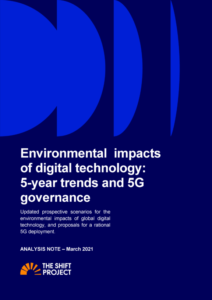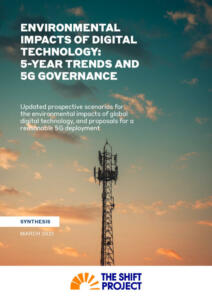How can we make the digital sector compatible with a 2°C emissions pathway? Which debates merit serious attention, and which players should be put in motion to work towards a resilient digital environment? How do we approach the current 5G debate, so as to build a digital gover–nance system that is both relevant and effective?
Problem statement and observations
Since 2018, our works on the digital sector have enabled us to lay out our vision for the concept of digital sufficiency. These observations, and the quantitative evidence backing them, have helped to raise awareness around the significant environmental footprint of the digital sector and the systemic factors which have led to its worrying growth. Since then, 5G bids have taken place in Europe, and the first installations have started. Concurrently, the health crisis has acted as a stark reminder to society that digital technologies are now a core component of essential services.
The progress of 5G roll-out in France and Europe offers us a window of opportunity to collectively reflect on how we can make digital transformation compatible with climate and energy-related constraints and how we adapt our decision-making mechanisms to consider the scale of our technology choices and their consequences.
The purpose behind debating these technological choices is not to embrace or reject any particular technology. Such debates are beneficial if they question what motivates the direction in which we take our digital environment, what justifies this orientation and how it is to be implemented across society. By re-examining the stalemate of the 5G debate, we can see that it is necessary to create the conditions for a collective discussion on technological choices that is broader, more effective, and centered on collective governance that has explicit goals.
Without this kind of analysis, our digital policies and development strategies will remain wasted opportunities in a digital transition that, ubiquitous as it may be, fails to take on the physical and societal challenges of this century.
Key objectives of this document
- Consolidate our quantitative estimates for the environmental impact of the global digital sector, by updating our scenarios from 2018;
- Use 5G deployment in France as a real-world illustration of the questions to be raised for scaling and managing a relevant digital system, based on reasoned and well-considered technology choices;
- Show how the current state of the 5G debate calls for building a broader and more effective collective discussion regarding our lifestyle and technology choices, that aims for digital governance in line with energy and climate-related constraints.



